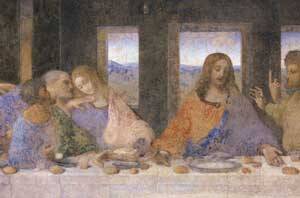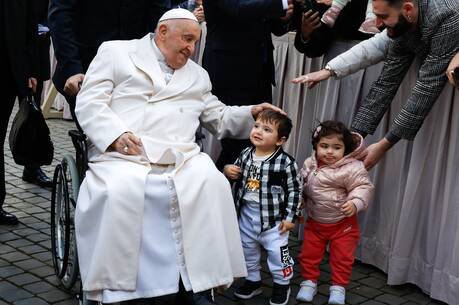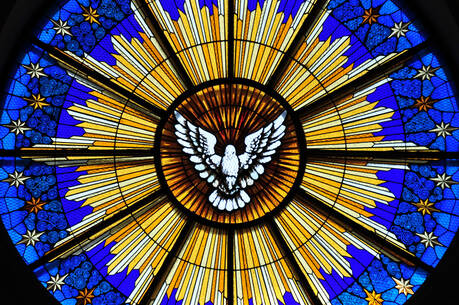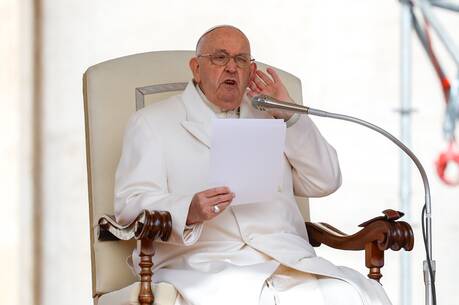A visit to an ancient refectory in Milan embodies a significant paradox in the relations of the Jewish and Christian traditions. On the wall of the old dining room is Leonardo da Vinci’s well-known fresco of the Last Supper, with Jesus and the disciples at table. And there, unexpectedly and incongruously, among the dishes and the wine cups is a loaf of bread. The problem turns on the familiar words of Matthew 26: “Now on the first day of the feast of Unleavened Bread the disciples came to Jesus, saying, ‘Where will you have us prepare for you to eat the Passover?’ And the disciples did as Jesus had directed them, and they prepared the Passover. When it was evening, he sat at table with the twelve disciples” (verses 17, 19-20).
Last Supper as Seder
The paradox is this: A Jew reading these words would understand immediately what is transpiring. Since it is a Seder, commemorating the Israelites’ preparation for their journey through the desert memorialized at Passover, the bread should not be leavened as in the mural, but unleavened, flat bread, less likely to spoil and, because it is light and compact, more easily carried on a journey. Most Christians do read Matthew, or hear the Gospel read, but some (like Leonardo) do not have a reflexive grasp of Matthew’s reference to the Seder meal and the unleavened bread prescribed for its celebration.
Mandated in the Bible as an annual commemoration of the Exodus from Egypt, Passover appears from the beginning to have involved a table celebration. At the heart of the commemoration was a seven-day abstinence from eating leavened bread. Jewish tradition mandates that during the entire week of Passover we eat Matzah—unleavened bread—in a re-enactment of the unleavened bread “our ancestors ate when they came out of Egypt.” How would Leonardo have known? It was one of those details that was simply lost over the ages as Christian knowledge of Judaism waned, and the focus of Christian piety became not the historical ties of Holy Week to the Exodus but Jesus’ Last Supper.
This unleavened bread, along with the four cups of wine that we drink during the Seder ritual, became the basis of the bread and wine of the Christian Eucharist. Thus the theme of Passover plays a significant role in the celebration of Holy Week and Easter. A sensitive attunement to the readings of Holy Week, particularly those for the Easter Vigil and Easter day, reveals how redolent they are with evocations of the unleavened bread and the Exodus narrative. The Last Supper account and Paul’s use of the leavened/unleavened metaphor to explain the new moral life of Christians in their faith in Christ, in the second reading (option b) of the dawn Mass for Easter (1 Cor 5:6-8), hearken back to the Passover. Thus the events of the Seder and the form and meaning of Passover can be a very real part of the events of Holy Week and of the central story of the Christian tradition.
What Matthew makes evident is the reality—and the reason—that the celebrations of Easter and Passover usually overlap on the calendar—usually, but not always. (In 2008 they were separated by a month.) The two sacred times share temporal space. This proximity has led more than a few perplexed people to ask, “Passover is the Jewish Easter, isn’t it?” (I have never heard the opposite formulation, however.) But are the two holidays really one? Or doublets? Actually their points of discontinuity and continuity intertwine like a braided candle. And, like a candle, they can shed much light.
Liturgy and Memory
The two holidays underscore much of what divides the two traditions. They celebrate two very different historical events. Easter commemorates the Passion and Resurrection of Jesus; for Jews those events play no role whatever in their religious lives. Passover celebrates the exodus of the children of Israel from Egyptian slavery; for Christians those events have mythic resonance but less personal significance.
There are also significant differences in the central religious vision of the two traditions. Easter reminds us that for Christians, Jesus is the central reality of Christian faith. The celebration of Passover, by contrast, highlights the centrality of the People of Israel itself to Jewish faith. It is the liberation of the People that gives the holiday its meaning. Passover underscores the almost mystical participation of each Jew in the totality of the history of the Jewish people. For Jews the Exodus does not have merely metaphorical meaning; nor is it felt to be some distant event. Rather, it is a tangible, immediate reality, so much so that the Haggadah, the liturgical text whose reading constitutes the Seder service, articulates the animating vision of the entire holiday—and perhaps of all of Jewish reading of the Bible: in every generation all Jews should regard themselves as if they themselves had gone out of Egypt. These two holidays are hardly a single entity.
The Seder experience and the Haggadah are the product of rabbis who sought to translate into concrete action the more general injunction of Exodus, “tell your son in that day saying, ‘it was because of what the Lord did for me when I came forth out of Egypt.’” The rabbis sought to ritualize the telling (Haggadah, in Hebrew). This insistence on applying biblical imperatives to concrete action is itself a radical distinction from the Christian rejection of such biblical literalism.
Although this resistance to literalism of action is characteristic of the sacramental churches, there is, even here, a provocative convergence with the Seder’s understanding of the Jews’ “entry into” the experience of the Exodus. We can hear echoes of a theology of participation in the celebrations associated with Holy Week and Easter. The baptism of catechumens and the renewal of baptismal vows for the baptized is seen as a participation in the death and resurrection of Jesus—and the entrance into a new creation, a new humanity.
The singing of the “Exsultet,” praising the paschal candle as the light of Christ, reviews for Christians salvation history culminating in Christ. The procession in darkness evokes the Exodus experience: the people of Israel were led through the desert by a pillar of fire by night. The readings of the Easter Vigil also make the connection explicit by recapitulating the history of the Jewish people.
Analogues to this participatory sensibility in Jewish practice can be found elsewhere in Christian life. In celebrating the Eucharist, in baptizing new members and in dramatic readings of the Passion, Christians see themselves as striving to carry out Jesus’ commands and sharing mystically in the events of Holy Week.
Troubled Memories
On a more somber note, these two festivals capture tragic realities in the relations of the two communities. Historically, for Jews, Easter and Passover were a particularly dangerous time of the year. In Europe the approach of Passover raised anxieties about the possibility of an eruption of a “blood libel”—the hoary lie that Jews would kidnap a Christian child and make use of his blood in the preparation of the Passover Matzah. This charge erupted throughout medieval and early modern Europe, precipitating terrifying and deadly assaults on Jews. It is this canard that we hear echoed in the “Nun’s Tale” in Chaucer’s Canterbury Tales. It continued to exert its malign influence in Europe up into the 20th century; and in somewhat altered form it finds expression in the Muslim world today.
Easter was the day of darkest dread for European Jews. As related in accounts of individuals who lived through the events and in collections of community chronicles, enraged mobs would pour out of the doors of the village church after a particularly inflammatory Easter sermon and run amok upon the Jews with whom they had been living amicably throughout the year, wreaking vengeance on the “perfidious Jews” for their unbelief, or worse, for the crime of deicide. Easter Sunday was often a very bloody time for Jews.
Recent history offers a new meaning to the convergence of these two festivals. The season of celebration once fraught with tension has become for most Christians and Jews an occasion for interreligious harmony and mutuality. The Seder itself has become less a barrier to amity than a bridge to understanding. Many Christian and Jewish congregations have celebrated the Seder together. More controversial are those Catholics and Protestants who participate in a form of Seder during Holy Week. Though the practice may be perceived by Jews as syncretism or as an appropriation of their own holy rituals, it stands as testimony to a recognition of common roots of faith and practice.
Since the Second Vatican Council the Catholic Church and many Protestant denominations have been energetic and vigilant about the way in which the Passion is taught. Indeed, the church has issued materials, including commentaries on the Lectionary, aimed at educating Christians about anti-Semitism precisely during Holy Week. What a remarkable reversal of the resonances this period held for Jews in pre-Nostra Aetate Europe! After Vatican II the church vigorously expunged from its liturgy prayers that would arouse enmity toward Jews. When in 2008 it appeared that this liturgical advance was to be rolled back, it was the memories of the old realities and the tragic consequences of the old practices that evoked an outcry in the Jewish community.
History has engendered other telling disjunctions as well. For Americans the assassination of Abraham Lincoln has, since 1865, burnished the motif—echoing Christ’s passion—of the martyrdom and unjust death of the saving one. The template shines through the poem Herman Melville wrote immediately after the assassination:
Good Friday was the day Of the prodigy and crime When they killed him in his pity When they killed him in his prime…. But they killed him in his kindness, In their madness and their blindness...
In the past 60 years, Passover too has assumed an additional significance. On the second day of Passover in April 1943, the remaining Jews of the ghetto of Warsaw began their uprising against the Nazi machinery of destruction. Jews regard the Warsaw Ghetto uprising, though it was futile, as an emblem of heroism and resistance—and as another instance of Jews, as a people, seeking to seize their freedom in the midst of oppression. As testimony to the capacity of Jewish religious practice to renew itself continually, the commemoration of the events of April 1943 has now found its way into many contemporary Haggadot. This adds another dimension of meaning to the annual commemoration of freedom.
Feasts of Rebirth
Of all the convergences of these two holidays, the most significant may lie not in the realm of history or of liturgy but in the world of nature. On the deepest level that convergence may be recognized most tellingly whenever Jews and Christians hear in each of these celebrations resonances of their common humanity.
It is no accident that both holidays are celebrated in the spring. I cannot imagine either of them occurring in the dead of winter. Both traditions celebrate a profound human reaction to the realities of our natural world; both celebrate the change of seasons. Passover celebrates that the earth has thrown off, at least in the Northern hemisphere, its mantle of snow and been reborn in all its verdant beauty. The Seder plate, which holds the symbols of the Passover service on each table, includes a sprig of parsley—or some form of green vegetable—and an egg. Both symbols evoke the reawakening of the earth, an integral part of the inner meaning of the observance.
Passover, no less than Easter, testifies in its own idiom to the miracle of rebirth. Passover speaks in the language of history and nature. The waters of the parted Red Sea speak of the rebirth of the People of Israel—liberated from the shackles of slavery, born anew as a people between the watery walls of the sea. The waters in which the parsley and egg are dipped during the Seder service evoke our rebirth from the tyranny of winter’s icy grip. Easter, too, is a festival of rebirth. Christians celebrate their liberation from death and sin. The Resurrection for Christians and the Passover for Jews both speak of being born anew, triumphing over death, being recreated.
Two festivals, very different, with differing meanings, evoke very different associations and memories. Yet on another level, the two share profound commonalities at the fundamental level of our shared humanity. How very representative of the relationship we are only now beginning to see between our two traditions! Collectively we are in the process of being reborn: from enmity and estrangement to new mutuality and fraternal affection. Perhaps someday we will evolve a shared commemoration celebrating that. It ought to take place in the spring.








